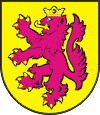Ceremonial hall renovated by Jewish Community of Brno. Dome photo [February 2009]
photo of cemetery [February 2009]
town image and website [February 2009]
JewishGen Austria Czech SIG [February 2009]
Alternate names: Podivín [Cz], Kostel [Ger], Kostl.The earliest Jewish community in Podivin in southern Moravia dates from the 15th century. The synagogue was representative of a style of masonry synagogue common in eastern Europe. Jewish population: 684 in 1857, 143 in 1938.
Possibly the oldest Jewish community in Moravia, according to Cosmas of Prague (d. 1125), a Jew named Podiva founded (1067) the castle which was named after him "Podivin";still the Slavic name of the town (Source: Pertz, "Monumenta Germaniæ Scriptores," ix. 80; D'Elvert, "Zur Gesch. der Juden in Mähren und Oesterreich-Schlesien," pp. 49, 52, Brünn, 1895; comp. Grätz, "Gesch." vi. 61). Local documents reach back only 200 years. According to popular tradition, the synagogue was built in the mid-1800s. The earliest tombstones are dated 1690. Kostel is one of the congregations of Moravia which possessed the rights of a township. With its branch at Eisgrub—the summer residence of the
REFERENCE: Carole Herselle Krinsky, Synagogues of Europe, P. 205-6. [February 2009]
US Commission No. CZCE000152
Alternate German name: Kostel. Podivin is located in Morava-Breclav at 48°50' N, 16°51' E , 27 miles SSE of Brno (Brünn). Cemetery: 0.5 km N, Plackeho-Str. Present town population is 1,000-5,000 with than 10 Jews.
- Town: magistrate Vlastimil Nemecek, Mestsky Urad, Namesti c 180, 691 45 Podivin; tel. 0627/951511.
- Regional: Engineer arch. Lydie Filipova, Okresni Urad, Referat Kultury, Masarykovo nam, 6900 00 Breclav; tel. 0627/414.
- Interested: Regionalni Muzeum, Director Dr. Dobromila Brichtova, zamek, 692 01 Mikulov; tel. 0625/2255.
- Caretaker with key: Bohumil Marek, Palackeho 330, 691 45 Podivin; tel. 0627/951546.
Earliest known Jewish community was 15th century. 1930 Jewish population was 196. [Jewish population: 684 (in 1857), 143 (in 1938)] Jewish community was a selfstanding political community 1880-1919. Rabbi Monis ben Jesaja Theomim, 17th century; Dr. Koppel Duschinsky, 19-20th century rabbi; and Dr. Eduard Kulke, 19-20th century rabbi lived here. The Jewish cemetery originated in second half of 17th century with last known Conservative Jewish burial in 1950s. No other towns or villages used this cemetery. Landmark Nr. 1655 S.M. The flat urban location, separate but near cemeteries, has inscriptions on pre-burial house. Reached by turning directly off a public road, access is open to all via a continuous masonry wall, a continuous fence, and locking gate. The approximate size of cemetery before WWII was about 0.8 ha and is now 0.7525 ha.
500-5000 stones, all in original location, date from 1694-20th century. The marble, granite and sandstone flat shaped stones, finely smoothed and inscribed stones, flat stones with carved relief decoration, double tombstones or obelisks have Hebrew and German inscriptions. Some tombstones have traces of painting on their surfaces and/or metal fences around graves. The cemetery contains no special memorial monuments or known mass graves. Within the limits of the site is a pre-burial house with wall inscriptions. Brno Jewish community owns the property used for Jewish cemetery and agriculture (crops or animal grazing). Adjacent properties are agricultural and residential. The boundaries are smaller than 1939 because of new roads or highways. Rarely, private visitors stop. Vandalism occurred occasionally 1945-1991. Local non-Jewish residents, regional/national authorities and Jewish groups within country did the restoration in 1980s. Brno Jewish congregation pays the regular caretaker. Serious threat: weather erosion. Moderate threat: vandalism. Slight threat: uncontrolled access, pollution, vegetation, existing and proposed nearby development.
Engineer arch. Jaroslav Klenovsky, Zebetinska 13, 623 00 Brno; tel. 0 completed survey on 1.3.1992. Documentation: Gold, Herman. Other exisiting documentation was not used. No site visits or interviews occurred.

